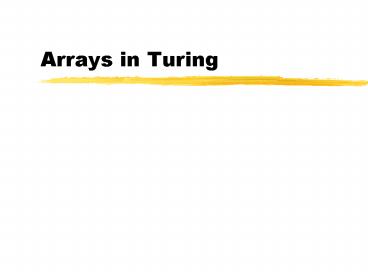Arrays in Turing PowerPoint PPT Presentation
1 / 11
Title: Arrays in Turing
1
Arrays in Turing
2
Need for Arrays - Why?
- Currently every variable can contain only one
data item at a time - Currently previous piece of information stored
will be replaced - This is called destructive input
3
Destructive Input
- Example
- var name string name "Fred Flintstone
- put "The name is ", name, "."
- name "Barney Rubble"
- put "The contents of name is ", name, "."
- name "George Jetson"
- put "The contents of name is now ", name, "."
4
Arrays
- Provide a mechanism so that all contents can be
stored under one variable - No more destructive input
- Each element is accessed by the name of the
variable and number of the content (subscript)
5
Arrays Ordering
- Use arrays to organize data in a specific order
(e.g. alphabetical/numerical) - Sorting requires the items to be available in
memory simultaneously for comparison
6
Declaration of an Array
- The following are sample declarations
- var names array 1..4 of string4 strings
accessed as names(1), names(2), names(3),
names(4) - var nums array 0..3 of int4 integers accessed
as nums(0), nums(1), nums(2), nums(3) - var realnums array 11..14 of real4 reals
accessed by realnums(11), realnums(12),
realnums(13), realnums(14) - var status array 1..4 of boolean4 booleans
accessed by status(1), status(2), status(3),
status(4)
7
Declaration of Arrays (Contd)
- Storing or accessing information to or from an
array must include assigning to the variable name
along with the subscript.
8
Example Program Using an Array
- The following program
- declares an array of 10 integers
- randomly generates numbers between 1 and 100
- stores them into the array
- displays the numbers in the order in which they
were generated
9
Continued...
- The Program also
- displays the numbers in the reverse order (last
to first generated) - then calculates and displays the average of the
10 numbers. - outputs the contents of the fifth element in the
array.
10
The Program
- declaring the array of 10 integers var nums
array 1..10 of int randomize - randomly generating 10 numbers between 1 and
100 and storing them in the array - for i 1..10
- randint (nums (i), 1, 100)
- end for
11
...
- output the list from the first to tenth
element. As i - increases from 1 to 10, it serves as the
subscript to - identify which array element we want. On the
first - iteration of the counted loop, i has a value of
1 so - nums(i) is accessing the contents of num(1),
etc. - put "The list of numbers between 1 and 100 that
has been .. - put generated is
- for i 1..10
- put nums(i)
- end for

